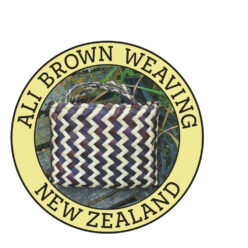21 November 2010
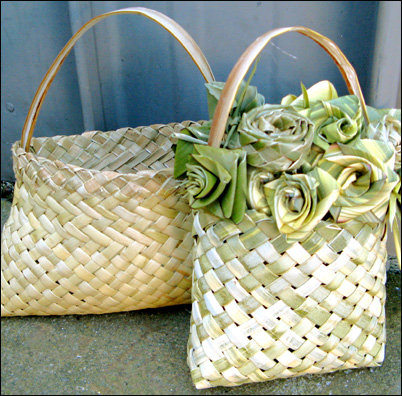 “What can I use this hard butt end of the flax leaf for? It seems such a waste to cut it up for compost.” This question is one that is regularly asked in my workshops and one that I keep in mind myself. The butt end of the leaf, where it grows from the base of the plant, is very strong and can be shaped into handles for little baskets like the ones pictured here. These handles have attractive markings, ranging from cream to brown to dusky pink, depending on the colour inside the flax leaf, and they are simple and easy to make. I keep a store of them on hand for those times when I’d like to put a handle on a basket but haven’t the time to plait one.
“What can I use this hard butt end of the flax leaf for? It seems such a waste to cut it up for compost.” This question is one that is regularly asked in my workshops and one that I keep in mind myself. The butt end of the leaf, where it grows from the base of the plant, is very strong and can be shaped into handles for little baskets like the ones pictured here. These handles have attractive markings, ranging from cream to brown to dusky pink, depending on the colour inside the flax leaf, and they are simple and easy to make. I keep a store of them on hand for those times when I’d like to put a handle on a basket but haven’t the time to plait one.
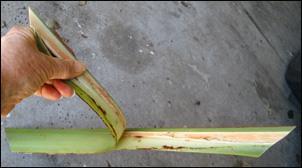 To make the handle, split the flax butt apart down the middle, separating the two parts of the leaf. If the butt end has been cut off the leaf, it may not be that easy to get started so use a knife or sharp object to separate the two sides of the butt apart. Once you’ve separated the sides, pull them completely apart. There may be a sticky gel inside the leaf, which is traditionally used as a skin-repair ointment or as a glue. You can wipe this off, but it will dry into a cellophane-like substance which is easy enough to pull off when it’s dry.
To make the handle, split the flax butt apart down the middle, separating the two parts of the leaf. If the butt end has been cut off the leaf, it may not be that easy to get started so use a knife or sharp object to separate the two sides of the butt apart. Once you’ve separated the sides, pull them completely apart. There may be a sticky gel inside the leaf, which is traditionally used as a skin-repair ointment or as a glue. You can wipe this off, but it will dry into a cellophane-like substance which is easy enough to pull off when it’s dry.
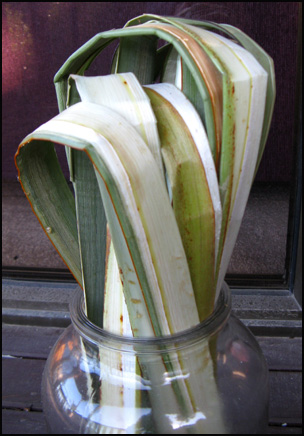 The next step is to bend the butt over and secure it in this shape while it dries. Before bending it over, scrape the side of the butt that will be the underneath side of the handle. This will help to soften the butt and make it easier to bend. You can bend the butt either way but some of the harder, thicker butts may bend easier one way than the other. Try to bend the butt smoothly so that it doesn’t get sharp folds, as the one on the right has in the photo here. These folds are impossible to smooth out once the flax is creased. Put the bent butts inside a container that will hold them in shape, like the wide-mouthed jar I’ve used here, and leave to dry, or tape them into shape.
The next step is to bend the butt over and secure it in this shape while it dries. Before bending it over, scrape the side of the butt that will be the underneath side of the handle. This will help to soften the butt and make it easier to bend. You can bend the butt either way but some of the harder, thicker butts may bend easier one way than the other. Try to bend the butt smoothly so that it doesn’t get sharp folds, as the one on the right has in the photo here. These folds are impossible to smooth out once the flax is creased. Put the bent butts inside a container that will hold them in shape, like the wide-mouthed jar I’ve used here, and leave to dry, or tape them into shape.
When the butt end is dry it is ready to be prepared for using as a handle. Trim the soft edges off and then split the butt into a width that seems suitable for your basket. I find that about half the width is a suitable size. The handle may be longer than you require, so hold the handle against your basket and measure the length that you need. The handle will need enough length to be able to be pushed in along the weaving at the side of your basket with about two centimetres more to fold back up to secure the handle from pulling out of the weaving.
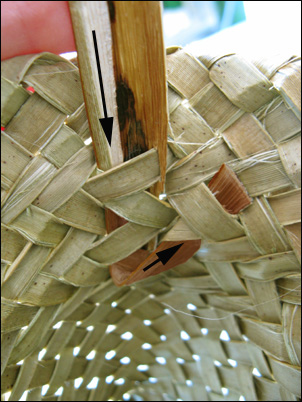 Once you’ve cut the butt to the correct length, trim the ends into a point and then push each one down through the weaving on each side of the basket, until a short end is sticking out from the weaving. Bend each end up and insert the end of the point underneath the closest strips to secure it. Pull the handle up gently so that the handle fits snugly in the weaving. This will secure the handle in place and make sure it doesn’t pull out as the flax dries. Alternatively, split the pointed ends of the handle into two and on each end bend one point up one side and one point up the other side to secure the handle.
Once you’ve cut the butt to the correct length, trim the ends into a point and then push each one down through the weaving on each side of the basket, until a short end is sticking out from the weaving. Bend each end up and insert the end of the point underneath the closest strips to secure it. Pull the handle up gently so that the handle fits snugly in the weaving. This will secure the handle in place and make sure it doesn’t pull out as the flax dries. Alternatively, split the pointed ends of the handle into two and on each end bend one point up one side and one point up the other side to secure the handle.
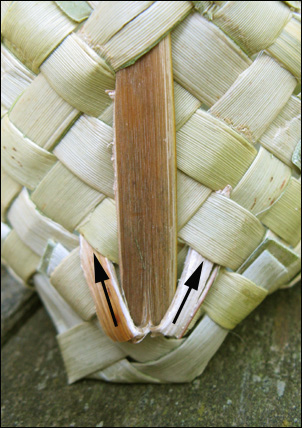 This can either be done on the inside of the basket, as in the photo above, or the outside of the basket as in the photo to the left — if it’s on the outside it can be a decorative feature. If the handle is very dry, it may be necessary to moisten the end before you bend it up, otherwise it may split.
This can either be done on the inside of the basket, as in the photo above, or the outside of the basket as in the photo to the left — if it’s on the outside it can be a decorative feature. If the handle is very dry, it may be necessary to moisten the end before you bend it up, otherwise it may split.
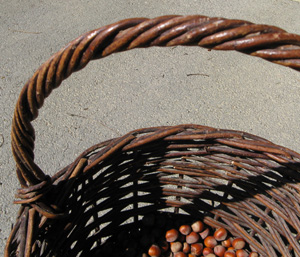 Using a hard but pliable material for a handle is a common way to make a handle in basket-making, although often the core material is covered with another material, like the handle on the willow basket pictured here. In this basket, the core is made from a thin bent willow branch, and this has been covered by winding finer willow branches around this core.
Using a hard but pliable material for a handle is a common way to make a handle in basket-making, although often the core material is covered with another material, like the handle on the willow basket pictured here. In this basket, the core is made from a thin bent willow branch, and this has been covered by winding finer willow branches around this core.
Although I think the flax butt handle is attractive as it is, with its subtle colouring and simplicity, it could also be covered and there are a variety of ways to do this. One way could be by making a patterned covering using the same technique that is used to make the wristband in the post Bands for the boys (and girls). If this technique is used, it would be important to make sure that the pattern on the handle is integrated with the style and pattern of the basket, if it has one.
© Ali Brown 2010.
Scroll down to leave a new comment or view recent comments.
Also, check out earlier comments received on this blog post when it was hosted on my original website.
